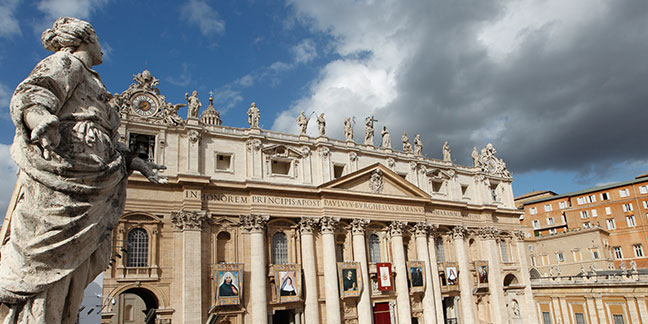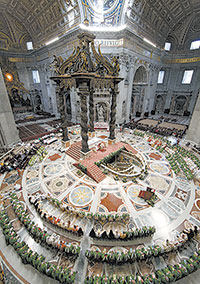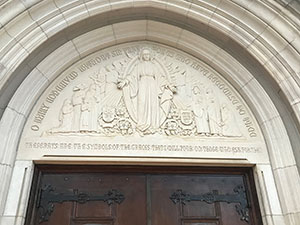 This feast celebrates the dedications of two of the four major basilicas of Rome, named for Sts. Peter and Paul, the Vatican’s patron saints and symbols of the Church’s unity and its universality.
This feast celebrates the dedications of two of the four major basilicas of Rome, named for Sts. Peter and Paul, the Vatican’s patron saints and symbols of the Church’s unity and its universality.
St. Peter’s Basilica was originally built in 323 by the emperor Constantine. The basilica was constructed over the tomb of Peter the Apostle, the first pope.
After standing for more than 1,000 years, Pope Julius II ordered the building to be torn down due to structural concerns. The construction of the new church spanned more than 200 years before its completion. It was dedicated on Nov. 18, 1626.
It is considered the most famous church in Christendom.
St. Paul’s Basilica is located outside the original walls of Rome. It was also originally built by the emperor Constantine, though it was destroyed by fire in 1823.
Donations from around the world made the reconstruction possible. Before the completion of St. Peter’s Basilica, St Paul’s was the largest church in Rome. The basilica was built over St. Paul’s grave, and Pope Pius IX consecrated it in 1854.
These two churches continue to draw millions of faithful pilgrims each year, as well as many visitors from other faiths.
— Catholic News Agency
What is a basilica? There are four “major” or papal basilicas – all of which are in Rome. All other basilicas are called “minor” basilicas.
There are four “major” or papal basilicas – all of which are in Rome. All other basilicas are called “minor” basilicas.
The Diocese of Charlotte has two minor basilicas: Mary, Help of Christians Abbey (better known as Belmont Abbey), and St. Lawrence Basilica in Asheville.
The Asheville basilica states on its website:
The term dates back to the early Greek and Roman times and referred to a type of public building. In the 4th century, basilicas began to be used as places of worship. It was during this time that construction of the greatest basilicas of Rome was started.
Today, the term basilica is a special designation given by the pope to certain churches because of their antiquity, dignity, historical importance or significance as a place of worship.
To become a basilica, the church must have been consecrated. The liturgical rites (celebration of the Holy Eucharist, sacraments of penance and other sacraments) should also be executed in an exemplary way with fidelity to liturgical norms and the active participation of the people of God.
It should also have special significance in the diocese. St. Lawrence, with its unique dome, is the only church designed and built by the renowned Rafael Guastavino.
Because of the relationship between a basilica and the pope, basilicas have the responsibility to promote the study of the documents of the pope and the Holy See, especially those concerning the Sacred Liturgy.
Also, certain days in the liturgical year are to be celebrated with added solemnity, among them the Feast of the Chair of St. Peter (Feb. 22), the Solemnity of Sts. Peter and Paul (June 29), and the anniversary of the election or coronation of the supreme pontiff.
An outward sign and privilege that comes to a basilica is the honor and opportunity to display the seal of the papacy.
Virtual tours online At www.vatican.va: Check out virtual 360-degree tours of St. Peter’s Basilica and St. John Lateran, along with other basilicas and chapels of the Vatican. Click on “Basilicas and Papal Chapels” on the bottom right of the page.
At www.vatican.va: Check out virtual 360-degree tours of St. Peter’s Basilica and St. John Lateran, along with other basilicas and chapels of the Vatican. Click on “Basilicas and Papal Chapels” on the bottom right of the page.
In honor of the Nov. 27 Marian feast, explore the history of devotion to Our Lady of the Miraculous Medal in the Gate City
 St. Benedict Catholic Church in Greensboro features a niche with a statue of Our Lady. The reverse side of the Miraculous Medal adorns the niche. Parishioners of St. Benedict have been praying the Novena to Our Lady of the Miraculous Medal for decades.A powerful and popular sacramental, the Miraculous Medal has roots in Greensboro that have grown and blossomed for well over a century, working miracles in souls and spreading the Catholic faith in the city.
St. Benedict Catholic Church in Greensboro features a niche with a statue of Our Lady. The reverse side of the Miraculous Medal adorns the niche. Parishioners of St. Benedict have been praying the Novena to Our Lady of the Miraculous Medal for decades.A powerful and popular sacramental, the Miraculous Medal has roots in Greensboro that have grown and blossomed for well over a century, working miracles in souls and spreading the Catholic faith in the city.
For as long as anyone can remember, parishioners at St. Benedict Church in Greensboro have prayed the Perpetual Novena in Honor of Our Lady of the Miraculous Medal. However, devotion to Our Lady under this title likely began at the church before the novena was written in Philadelphia in 1930.
It may have started as early as 1899 when construction was complete for St. Benedict Church, the permanent home of the city’s first and only Catholic parish at the time. Photos show that the medal appeared above a statue of Mary in the original sanctuary and may have ties to the church’s benefactress, St. Katharine Drexel, also from Philadelphia. The popularity of the medal grew in 1906 when the Daughters of Charity of St. Vincent de Paul arrived in Greensboro from Emmitsburg, Md., to open St. Leo’s Hospital and serve at St. Benedict.
The religious order, which was dedicated to the Blessed Mother from its founding, has strong ties to the Marian apparition depicted in the medal. Our Lady appeared three times in 1830 at the order’s Paris motherhouse to Sister Catherine Labouré, a Daughter of Charity and future saint whose feast day is Nov. 28.
An Unexpected Visitor
In an apparition on Nov. 27, 1830, the Blessed Mother asked Sister Catherine to have a medal struck in the way she appeared during the vision. First the front of the medal was shown: Mary standing on a globe, with the head of a serpent beneath her feet. Rays representing graces beam from jeweled rings on her fingers. Encircling the oval shape around Our Lady is the signature, “O Mary, conceived without sin, pray for us who have recourse to thee.” On the reverse, 12 stars surrounded a large “M,” surmounted by a cross. Below the “M,” were two hearts: one circled with thorns, representing Jesus, the other pierced by a sword, symbolizing Mary.
During this dazzling vision, St. Catherine heard a voice tell her: ‘Have a medal struck after this model. All those who wear it will receive great graces; they should wear it around the neck. Graces will abound for those who wear it with confidence.’”
The medal was struck and spread far and wide in a short amount of time as its wearers reported miracle after miracle, such as dramatic healings and conversions. Devotion to Our Lady under this title has worked subtler miracles too.
“It’s been a great source of comfort, especially after the loss of my husband George in July and my daughter just three years ago,” said Roberta Van Pelt after the Nov. 19, 2023, recitation of the Miraculous Medal Novena at St. Benedict.
Van Pelt has prayed the novena since 2015 and now leads the novena recitation before the Sunday Vigil Mass each week.
“When my husband was in hospice, I prayed that I would be with him when he died,” she said. “I was there when he closed his eyes.”
Font of Religious Vocations
Devotion to Mary under this title is known to foster religious vocations and has a famous example in Alphonse Ratisbonne, an Austrian Jew, who was intensely anti-Catholic. Ater reluctantly agreeing to wear the medal and pray The Memorare, he experienced an apparition of Mary as she appears on the medal and was eventually ordained a Catholic priest.
The people of St. Benedict parish have sought the intercession of Our Lady of the Miraculous Medal for decades. Some of them must have been praying for vocations because there have been an impressive number of them from the small parish.
Monsignor Joseph Showfety, the first chancellor of the Diocese of Charlotte, was one of three examples of priestly vocations from the early days. He was ordained in 1955. Another was Father Thomas Berry, who was ordained in 1942 and had two sisters with religious vocations. In fact, eight young women at the parish went on to become religious sisters. More religious vocations sprang up, but somewhere along the way the parish lost count. There are records, however, of a boom during the 1985-1993 pastorate of Father Kimbrough. Nine men from St. Benedict went into the seminary, and three women became religious sisters.
Spreading the devotion in Greensboro
 A limestone carving of Our Lady of the Miraculous Medal and related figures such as St. Catherine Labouré adorns the main entrance of Our Lady of Grace Church in Greensboro. Also on the carving are the words that appear on the medal: O Mary, conceived without sin, pray for us who have recourse to thee."
A limestone carving of Our Lady of the Miraculous Medal and related figures such as St. Catherine Labouré adorns the main entrance of Our Lady of Grace Church in Greensboro. Also on the carving are the words that appear on the medal: O Mary, conceived without sin, pray for us who have recourse to thee."
Devotion to Our Lady of the Miraculous Medal spread in 1928 to St. Mary’s, a mission of St. Benedict serving Black Catholics in Greensboro. The Emmitsburg motherhouse sent three Daughters of Charity to Greensboro to start a teaching apostolate at the mission’s Our Lady of the Miraculous Medal School with the church also bearing this title from 1948 to 1972. Around this time, devotion to Our Lady of the Miraculous Medal was skyrocketing in the United States, thanks to the work of Father Joseph Skelly, CM, who commissioned a shrine to Our Lady of the Miraculous Medal in Philadelphia. On Dec. 8, 1930, Father Skelly started the perpetual novena at the shrine, now prayed at St. Benedict and many other churches throughout the world.
In 1952, something grand happened to grow the Catholic faith and Marian devotion in Greensboro: the dedication of Our Lady of Grace Church. A memorial to St. Benedict parishioner Ethel Clay Price, the church’s patroness is the same as the one on the medal. She is seen in an array of colors in the stained-glass window behind the altar. A limestone carving of Our Lady of the Miraculous Medal graces the main entrance to the church along with key figures such as St. Catherine in her religious habit and the words the Blessed Virgin spoke to her. The devotion continues to be passed down to new generations. Leading up to the feast in 2023, children in all grades of Our Lady of Grace School learned more about the apparitions and created their own Miraculous Medals.
Today, the perpetual novena at St. Benedict is prayed before a statue of Our Lady within a niche once again adorned with the Miraculous Medal after the church's 2017 restoration. Parishioners come each week with their petitions seeking the Blessed Mother’s aid as well as her love and comfort. In the apparition, Our Lady told St. Catherine that the rings on her fingers that weren’t emitting rays of light represented unasked for graces, gentling reminding her children of what her Divine Son told us: “Ask, and it will be given you.”
— Annie Ferguson. This article includes research the author conducted for her book, “Pioneering Spirit: The History of St. Benedict Catholic Church From Inception to Restoration.”

